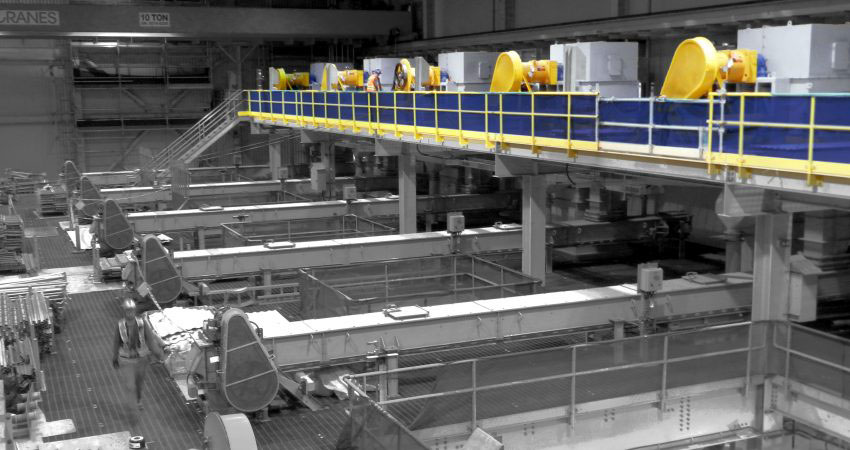(Almost) Everything You Wanted to Know About Bucket Elevators
“What goes up must come down” is a quote (attributed to Isaac Newton) and a concept (the law of gravity) that most people are familiar with.
When applied to conveying material, the second part should be adjusted to: “What goes up probably needs a bucket elevator.”
One of the many types of bulk material handling equipment offered by CDM Systems, bucket elevators specialize in vertical or high-lift conveying of large amounts of material using a series of buckets. They can be found in multiple industries and are effective at handling a variety of materials ranging from heavy iron ore pellets to powdery, dusty, dry material such as sand and fly ash.
But just as this equipment can handle more than one type of material in more than one industry, there is more than one type of bucket elevator: centrifugal and continuous. Our Bucket Elevators Info Sheet goes into more illustrated detail about the differences between the two, but in basic terms:
Centrifugal bucket elevators are used most frequently for free-flowing, fine or powdered materials such as grain, clay, sugar, finished cement and dry chemicals.
- Malleable iron, steel or synthetic buckets are mounted on a chain or belt.
- Buckets are mounted at specific intervals and operate at relatively high speeds.
- A combination of material flow and a digging boot loads the buckets.
- Buckets use centrifugal force to eject material.
Continuous bucket elevators are recommended for large-capacity, severe-duty applications that handle friable materials.
- Steel or synthetic buckets are mounted on a single chain or two chains on each side.
- Buckets are mounted continuously and travel at relatively slow speeds.
- A direct feed on the up-leg side of the elevator loads the buckets.
- Buckets use gravity to discharge material.
These differences only tell part of the story. The specific industry in which the equipment will be operating is another important factor in the bucket elevator selection process. Our individual industry pages offer additional insight and equipment recommendations, but here are some general guidelines for the industries we serve:
- For the biomass industry, continuous bucket elevators are not typically desired, but they can be effective in the back end of a process, with centrifugal bucket elevators handling the front end.
- For the cement industry, continuous bucket elevators are ideal for handling highly abrasive material such as clinker. Centrifugal bucket elevators are ideal for handling less-abrasive material such as finished cement.
- For the glass industry, continuous bucket elevators are better suited to handling abrasive material with less degradation, so centrifugal bucket elevators are not typically desired.
- For the minerals and mining industry, continuous bucket elevators are ideal for handling highly abrasive, inconsistently sized, friable material. Centrifugal bucket elevators are ideal for handling material with the opposite characteristics.
- For ports and terminals, continuous bucket elevators are not typically desired, as centrifugal bucket elevators are better suited for high speeds and handling high volumes of less-abrasive, free-flowing material.
- For the potash and fertilizer industry, continuous bucket elevators are best for operations that produce granular material. Centrifugal bucket elevators are best for operations that produce non-granular material.
- For the power industry, continuous bucket elevators are ideal for higher volumes of abrasive material such as ash or limestone. Centrifugal bucket elevators are ideal for handling low volumes of non-abrasive material such as fuel.
- For the pulp and paper industry, continuous bucket elevators are recommended for handling higher volumes of abrasive material such as wood waste or ash on the back end of a process. Centrifugal bucket elevators are recommended for handling lower volumes of non-abrasive material such as fuel on the front end of a process.
And there you have it: (almost) everything you wanted to know about bucket elevators. To learn more about why CDM bucket elevators are the ideal vertical conveying solution for a variety of materials, elevations and discharge requirements, contact a CDM expert today. With more than 40 years of experience building bucket elevators in a variety of configurations, we are uniquely qualified to help you make the right equipment decision that will literally take your material handling to the next level.
———
About CDM
The CDM story is about recognizing every industrial operation is different, as are their conveying challenges. A custom-engineered conveying system is a cost-effective approach to any operation willing to look at the value of having a partner who is vested in your success and one who stands by their product. CDM has earned more than 91 percent repeat business because we’re more than just a conveying systems manufacturer – we’re a business partner.
For further information contact:
Andrew Parker, President CDM Systems, Inc.
Browse By Benefit
Categories
- Blog (40)
- Case Studies (9)
- News (7)
- Product Information (7)
- Tech Briefs (3)
- Technical Documents (33)
- Uncategorized (1)
- Videos (12)
- White Papers (5)


